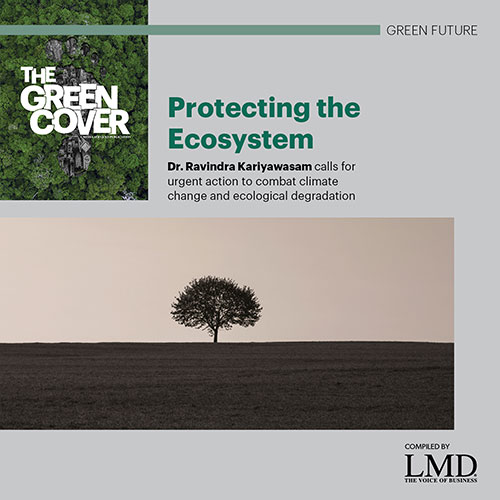CORPORATE PROFILES
COMMERCIAL BANK OF CEYLON
 Q: In what ways can an organisation’s sustainability goals support its corporate objectives? And how does this factor into Commercial Bank of Ceylon’s operations?
Q: In what ways can an organisation’s sustainability goals support its corporate objectives? And how does this factor into Commercial Bank of Ceylon’s operations?
A: Sustainability facilitates the alignment of business strategies to serve a purpose beyond profits and the delivery of meaningful value to stakeholders.
As a bank, we seek to meet this objective by influencing clients through solutions such as green financing, and our Social and Environmental Risk Assessment System (SEMS) in lending.
Being a financial services institution, our operations have a comparatively smaller impact on the environment but we’ve been able to minimise our emissions and consumption of resources further as part of the bank’s commitment to sustainability.
Moreover, considering environmental, social and economic impacts provides management with a holistic view of organisational performance in decision making while facilitating the attainment of corporate objectives.
Q: What does becoming the first 100 percent carbon neutral bank in Sri Lanka mean to you?
A: Commercial Bank has always strived to work towards the enhancement of shareholder returns without compromising its responsibility to society and the environment.
Being one of the largest private commercial banks in Sri Lanka with an extensive islandwide presence, achieving this ‘carbon neutral’ status becomes vital to us; and it is no easy task, given the time and resource commitment, and investment in gaining this accomplishment.
The bank is strongly committed to reducing its environmental impact. We believe that this step has also enabled us to lead by example among stakeholders – particularly customers whom we can now steer in the right direction with our green solutions.
 Q: Could you outline the measures taken by Commercial Bank to meet this goal?
Q: Could you outline the measures taken by Commercial Bank to meet this goal?
A: The bank began the process of measuring its carbon footprint many years ago. Initiatives such as the installation of solar photovoltaic (PV) systems, efficient air conditioning systems and LED lighting were introduced even before this process began.
At present, many of the bank’s branches are powered partially or entirely by solar energy. This has reduced the consumption of grid connected electricity in addition to total greenhouse gas emissions.
The multifaceted green initiatives that contribute to the bank’s carbon neutrality status include lending to eco-friendly operations; migrating to paperless banking; reducing the consumption of nonrenewable energy, water and other resources in its operations; and supporting community initiatives that help conserve habitats and the environment.
Commercial Bank financed the first commercially viable wind power project and commercial scale solar power project developed in Sri Lanka among numerous other environmentally focussed initiatives.
The bank is also one of the pioneer members involved in the formulation of the country’s Sustainable Banking Initiative (SBI) in partnership with 18 members of the Sri Lanka Banks’ Association (SLBA).
Furthermore, Commercial Bank’s green financing is geared towards the fight against climate change and meeting the UN Sustainable Development Goals (SDGs).
The bank also purchased carbon credits from a wind energy project registered under the Clean Development Mechanism of the United Nations Framework Convention on Climate Change (UNFCCC), which contributed to its achievement of carbon neutrality.
Meanwhile, Commercial Bank funded the planting of 2,000 mangrove plants on a small island in the Koggala Lake. This was the first phase of a mangrove restoration project while the second entails the planting of another 3,750 mangrove saplings.
Q: Does the bank measure performance against sustainability related indicators? If so, what are they – and how are they evaluated?
A: The bank follows a meticulously crafted sustainability strategy and blueprint. Once annual business objectives and targets are set, sustainability targets are aligned accordingly. These targets are derived on the basis of each function’s core activities.
For example, the Premises Department would have measurement indicators such as the energy reduction to be achieved in percentage terms, the number of branches to be converted to solar power and so on.
 The Risk Department’s sustainability dashboard would include metrics such as exposure to ‘negative list’ and ‘exclusion list’ activities, as identified in the bank’s social and environmental policy, due diligence statistics and corrective action plans.
The Risk Department’s sustainability dashboard would include metrics such as exposure to ‘negative list’ and ‘exclusion list’ activities, as identified in the bank’s social and environmental policy, due diligence statistics and corrective action plans.
And finally, the bank’s green financing function’s measurement parameters would entail the achievement of stipulated portfolio growth over the year.
Commercial Bank’s Managing Director S. Renganathan, Chief Operating Officer Sanath Manatunge, Assistant General Manager Services Chinthaka Dharmasena (fourth, third and second from the right respectively) and senior bank officers receiving a certificate from Sri Lanka Climate Fund officials.
Some of the bank’s sustainability initiatives.
Renganathan
Managing Director
Chief Executive Officer
Telephone 2486000 | Email info@combank.net | Website www.combank.lk





